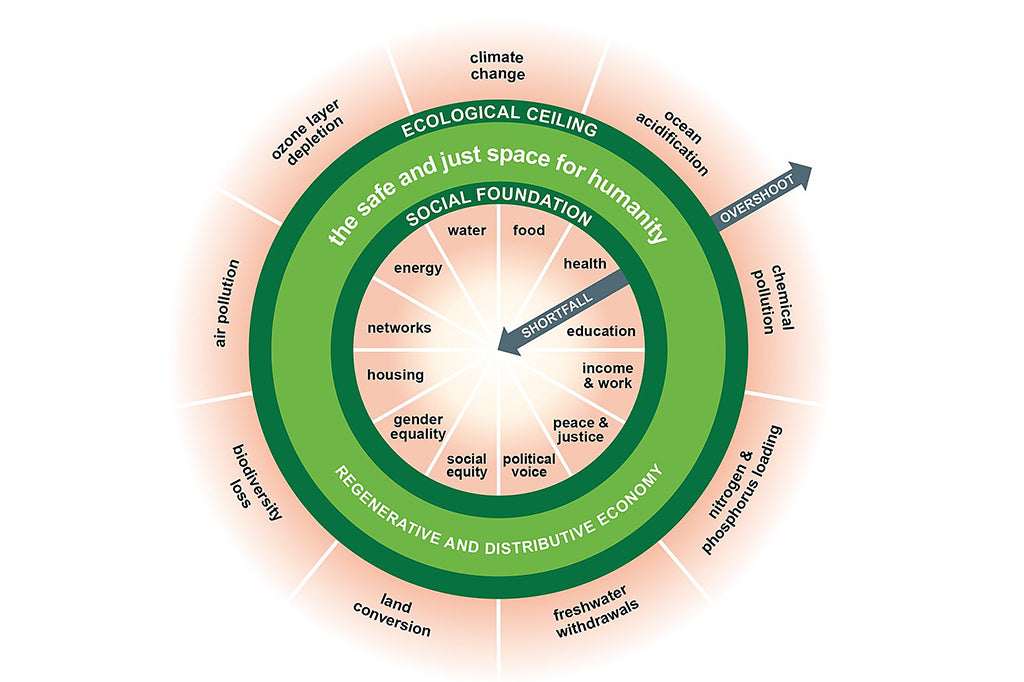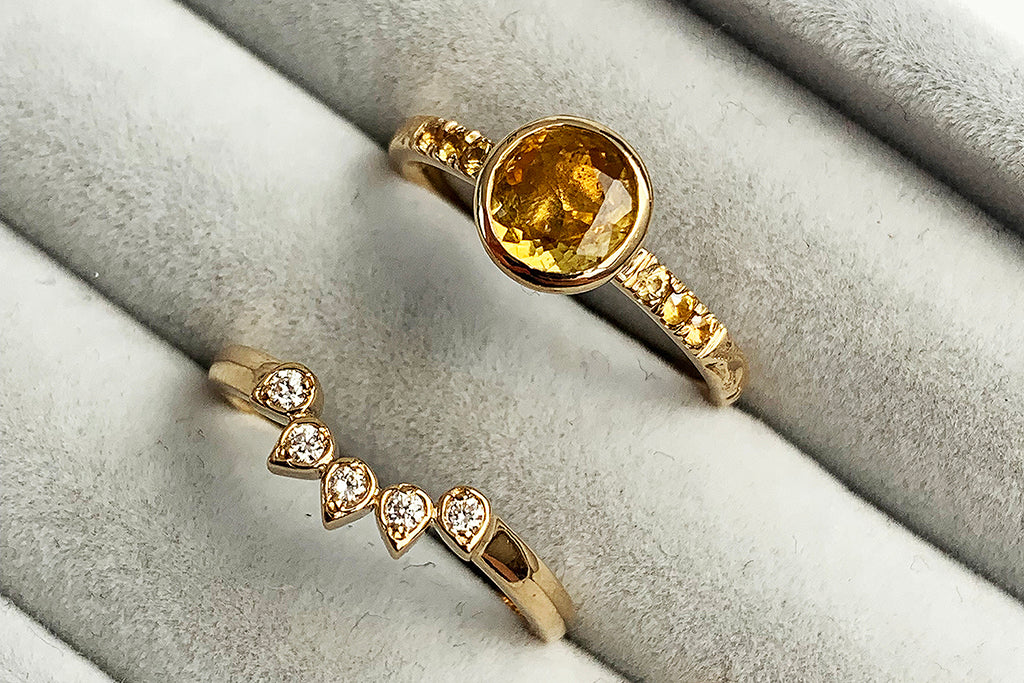Your Cart is Empty
Gemstone size, setting style, band width, decorative accents, practicality, longevity. The process of choosing an engagement ring – a visible and highly symbolic ‘forever’ jewel – involves a whole lot of consideration. For those of us who wish to ensure that our purchases align with our personal values, perhaps the most important decisions of all are those relating to materials and production processes; those which determine the ultimate impact of our jewellery on the world.
“Is recycled gold better than newly mined gold?” is one of the questions most frequently asked in our consultation room. Our response? That’s for you to decide. In the context of jewellery, there is no one-size-fits-all definition of the word ‘ethics’. Just like the jewellery industry’s issues are complex and multifaceted, the solutions available to us as 21st century designers and consumers are varied. That’s why we offer a variety of material options, boasting a variety of environmental and socioeconomic benefits.
In order to navigate these possibilities, we first encourage you to spend some time educating yourself on jewellery industry issues that need addressing. Then, when you feel suitably informed, make some instinctive decisions about how your purchase might serve as a solution. Think of this as your personal ‘redemption equation’ – and use this blog post as your girl math guide.

As an ethical jeweller, our offering evolves to reflect ever-changing environmental, social and political landscapes. The lens through which we currently choose to view the world is the Doughnut Economics framework, which concerns itself with the simultaneous demands of people and planet. Humanity’s challenge in the 21st century is to ensure that nobody falls short on life’s essentials (food, water, shelter, education, political voice, etc.) at the same time as reducing our collective strain on our planet’s vital life-supporting ecosystems (a stable climate, fertile soils, clean oceans, a protective ozone layer, etc.) In an ideal world, we exist comfortably within the social foundation and ecological ceiling – within the Doughnut.
And so, as an ethical business, every decision we make is centred on two fundamental questions:
Our redemption equation deals in both socioeconomic reparations and environmental efforts, balanced (more or less) on a 50/50 scale. Alongside traceable artisanal materials like Fairmined Ecological Gold, we offer recycled gold. As well as donating a fixed quarterly sum to The Water Project’s work in Sierra Leone, we plant 10 new trees for every piece of jewellery sold. The girl math behind your engagement ring purchase could be made easier by the underpinning of a similar framework.

One of the key challenges of measuring the environmental sustainability of recycled gold is the lack of concrete figures.As it stands, there is no accurate data about the actual emissions that are used or generated when we recycle gold.
What we do know, however, is that recycled gold is not footprint-free. The complex process of recycling gold requires energy, which creates emissions, and it’s still not yet clear whether toxic chemicals like mercury are used in some instances. When weighing up the pros and cons of choosing recycled gold over an artisanal or small-scale mined (ASM) alternative, it’s important to bear in mind that it’s not necessarily a free pass as far as the environment’s concerned.
That said, no new piece of jewellery could ever exist without environmental ramifications of some degree – it’s just about choosing where on the ‘environmentally friendly scale’ you’re comfortable with your engagement ring sitting.
Put simply, utilising material which is already above-ground reduces the demand for further mining. Gold is eternally regenerative and won’t biodegrade, so it makes sense to reuse it; particularly since research has proven that all the gold ever mined since the beginning of human history is still existing with us above the Earth’s surface. What an opportunity!
Regardless of the complexities, recycling gold is not a process which involves digging a hole in the ground and taking finite resources from the earth’s crust with the help of heavy duty machinery and toxic chemicals. If your environmental values deem extractivist activities unnecessary, choosing an engagement ring that consists of 100% recycled materials is a no-brainer.
As we know, however, environmentalism is only one fraction of the ethical equation.
 Fahad’s custom-made engagement ring and wedding band set, created in Fairmined Ecological Gold
Fahad’s custom-made engagement ring and wedding band set, created in Fairmined Ecological Gold
Because gold is a financial asset, often interchangeable with currency, and utilised by myriad industries besides jewellery, the demand for newly mined gold is not impacted by the increased demand for recycled gold. Though it’s perfectly reasonable to shun extractivism and choose to separate yourself from mined gold for the sake of your own principles, mining will continue regardless.
The power we dohave, however, is to drive demand for traceability by carefully choosing how we source our newly mined gold. The world is home to roughly 15 to 20 million ASM miners who rely on gold mining for a legitimate source of income. If your redemption equation holds space for newly mined materials, there are crucial opportunities to support these people by championing responsible mining practises.
Certification schemes like Fairtrade Gold and Fairmined enable jewellers like us to trace our gold back to their ASM origins, assured that it’s been extracted via best practise principles. We pay premiums for our licenses to use these metals; funds which are invested directly in the miners and their communities in the form of education, healthcare, environmental projects, and resources like electricity and clean running water. Fairtrade- and Fairmined-licensed mines are thoroughly regulated, ensuring safe working conditions, fair wages, and careful consideration of the environment surrounding the mines.
But when performing your ethical girl math, it’s worth taking into consideration that there are some differences between Fairmined Ecological Gold and Fairtrade Gold, which are the two ASM golds that we offer here at Lebrusan Studio. Whilst Fairtrade Gold is still extracted with the use of cyanide, the mining of Fairmined Ecological Gold involves no toxic chemicals whatsoever. What’s more, there are Fairmined Ecological Gold mines in Peru, for example, where practises are entirely circular, from water resources to electricity and the storing of excavated earth.
Of course, the primary benefit of choosing either ASM gold is the long-term socioeconomic sustainability your purchase facilitates. Fairmined Ecological Gold is particularly special, however, because it champions environmental sustainability at the same time. As far as the Doughnut is concerned, Fairmined Ecological Gold cleverly balances the equation.
 Raiyah’s bespoke engagement ring, created using a combination of Fairtrade Gold and recycled gemstones
Raiyah’s bespoke engagement ring, created using a combination of Fairtrade Gold and recycled gemstones
Of course, for many people, the ultimate design and make-up of an engagement ring is governed primarily by the scope of their budget. Though traceable artisanal gold like Fairtrade Gold and Fairmined Ecological Gold is a beautiful investment because of its positive socioeconomic output, it’s this traceability – and comparative rarity to ‘industry standard’ gold – that makes third party certified gold considerably more costly. Fairmined Ecological Gold is our most expensive option, with Fairtrade Gold costing roughly 10% less, and recycled gold approximately 10% less than that. Wherever you choose to shop, you will find that recycled metal is a cheaper option than anything traceable and third party certified. The story is the same for diamonds and gemstones.
Stripped down to its bare bones, an engagement ring consists of two fundamental parts: its central gemstone and its metal band. If you’re keen to purchase an engagement ring whose primary purpose is a positive socioeconomic impact, but can’t afford to commission one that ticks this box by way of both of its parts, choosing recycled gold would bring down the price - thus enabling you to invest a little more in the artisanally-mined Ocean Diamond of your dreams. Likewise, forfeiting a traceable newly-mined diamond for a more affordable recycled stone would leave more room in your budget for a traceable, artisanally-mined metal. See this 50% compromise not as a failing, but a decision that enables you to make somepositive socioeconomic impact instead of none at all. By Lebrusan Studio’s calculations, an engagement ring that treads this balanced line is a triumphant creation that does the Doughnut proud.
Whatever the outcome to your personal girl mathing, remember that the key to a solid redemption equation is integrity. Do your research, don’t be afraid to ask questions, and listen to your instincts.
